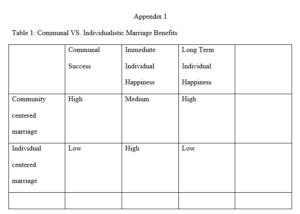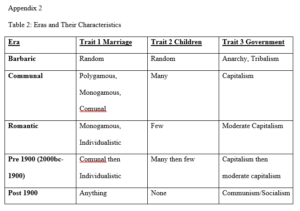PDF Version:
The Post-Romantic Evolution of Mating
Introduction & Thesis
Pre 1900 Marriage (1000-1900 a.d.) was marriage with community friendly values. Community friendly values are values which support a strong community. Post 1900 marriage was individualistic. Individualistic marriage is any mating arrangement which is calculated to bring immediate individual satisfaction at the expense of all other values.
Marriage after 1900 gained some strengths, but mostly lost strengths. There is more freedom to choose which mating lifestyle you chose today, but there is a disregard for community today. Pre-1900 marriage used mating arrangements to fix the economy from the inside out. Post 1900 marriage used mating arrangements to fix people, and asked government to fix the economy. Since government is just another word for people, this theory failed.
Era Definitions
-Barbaric Mating era: The barbaric era I will refer to as anything preceding 2000 b.c. When Coontz (2005) refers to “traditional” not always being “traditional”, she is speaking of the barbaric evolution of marriage which occurred before the communal marriage era. This includes wife swapping and sale of children. Marriages much earlier than our pivotal time of 1900 were in a developmental / barbaric / non-civilized stage.
-Communal Mating era: 2000 b.c. – 1300 a.d. The communal marriage era was followed by the romantic era.
-Romantic Mating era: The romantic era was about 1300-1900. It was followed by the post 1900 progressive era.
-Pre 1900 Mating: When referring to Pre 1900 marriage in this paper, we are referring to marriage from approximately 1000-1900. This is a combination of years 2000 b.c. – 1900 a. d.
-Post 1900 Progressive Mating era: Moving from economic / communally based marriages to marriages for pleasure; the result of the Romantic era. The ripe fruits of Romanticism.
Pre-Communal Barbaric Marriage
The ideal for marriage had been obtained by the preromantic era. Before the renaissance and enlightenment, most societies treated women as sex toys, abused them, and didn’t train their posterity. It was barbaric. The term barbaric can mean “non-Greek”, and has always been a way of saying “uncivilized”, or “untampered for the common good.” We will see how Romantic marriage and Post-Romantic marriage is similar to barbaric marriage. Barbaric marriages were not long term, were easily obtained, and easily discarded. The woman was silent. Romantic marriages can also feature quiet women, but in a different way. Romantic women are quiet in their majesty, being revered by men. Barbaric woman are quiet in fear, hiding from the muscles of their wild men, obeying them for fear of their lives. Indeed, murder itself wasn’t very punishable in mediaeval or Eskimo type societies. They acted like animals.
Pre-Romantic Communal Marriage
Marriage for many millennia had its several changes and variations, but one thing remained the same: marriage was for community. Marriage was an arrangement which benefitted children, and benefitted a man’s vocation. Vocation and children were the two pillars of society. The children were raised to be good citizens, and the vocations were the engine of the economy. Thus we may say that economy was the engine of pre-20th century marriage. Woman stayed at home and taught their children to be good, and men stayed away from home contributing to the economy. This is not surprising because hunger and poverty had been large issues that never seemed to go away, and a focus on economics was the surest way to alleviate suffering. There was still adoration of the spouse in this pre-romantic era, but it wasn’t so persuasive that it overwhelmed the sound necessities of social order.
Romance
Though we often hold romance as a high ideal of life, it has its dark side. In fact, the roots of post 20th century marriage can be traced to the evolutions which took form in the Romantic period, when logistics of mating were converted from communally based to individually based.
Marriage became “romantic”, wherein the focus shifted to the lovers, rather than the context they were loving in. This created a wake which pervaded, some say destroyed, modern 21st century marriage. How is this? People argue that all that matters is what the couple wants. This is what makes homosexuality a popular idea – the satisfaction of consenting adults. The polygamy movement is also powerful in this case. A case in point of the degeneracy of romantic marriage is Lord Byron. He wrote beautiful poetry, but was a cruel husband. Romance looks good but leaves a person wanting for something.
Cycling Between Tradition and Progressivism: Post 1900 Marriage
It seems that in the 2000’s, that a new breed of suffering came to the spot light; now that Americans were prospering in their suburbs and enjoying technological conveniences, issues of mental health began to rise. Now a person could have more legitimate issues than an empty stomach, or other economic issues. Hence we used the doctrine of Romanticism to bring about a whole new way of living: the individual was first, not the community. The community had learned how to survive economically. Economics was the reason for community. But now, the individual had his turn to look to higher needs. Loneliness of being single became a real issue. Sexual hunger was now to be addressed now that physical hunger had been addressed. The Great Depression is a mysterious chapter. It shows that a society who thinks they had everything figured out still doesn’t really understand how to keep a person from being physically hungry. This lead people back into a primitive time. The 1950’s looked much like the 1850’s, people were going back to the basics of community, marriage for children, man focusing on a vocation, woman focusing on raising the children (Coontz, 2005, p. 230) each for the foreordained societal roles as determined by their gender. Just like how the 1850’s and 1950’s looked similar, so did the times of 1870’s and 1970’s. These were the times of revolution. The times of rebellion against the communal economically based society. Their physical hunger had been met so it was time they changed the stability into something hopefully better.
Pre & Post 1900 Mating Case Study: Polygamy
Polygamy is no longer seen as back woods people in their misogynist traditions, but is seen as a group of intelligent consenting adults. Until a band of college professors got together and said, ‘we are consenting adults living together, let us call ourselves married’, the courts never thought twice about allowing polygamy. Now polygamy and its close relative polyamory are closer than ever to becoming another embraced way of life. A case in point of wonder on this topic is that another modern American group, a show case of pre-1900 citizens, the Mormons, wanted polygamy, but were persecuted for doing it, put in jails, chased from state to state into a wilderness, until finally when their temples (most sacred houses of worship in the Mormon faith) were threatened by the state. The modern polygamist in states where polygamy is popular (Utah, Idaho, etc.), even though technically this practice is illegal, the people practicing it are not prosecuted because the government doesn’t think it worth their time. So there is an advantage in living in post 1900 marriage times, there is more freedom for things considered non-traditional. Although the Mormons and other polygamists may well site many cases of their polygamy as being quite traditional, just a more ancient tradition. So post 1900 is a better time for a person wanting marriage because he can do it in whichever way his conscience pleases. The polygamy case of pre and post 1900 also represents a potential fear however, that the term marriage will become so dissected that any semblance of regularity will entirely disappear. Polygamy was taking it too far said the American courts of the 18th century, and those of the 21st century are now saying that those against non-traditional marriages, particularly homosexuality, are not being fair. Fairness seems to be the motto of contemporary marriage customs in the United States, whereas righteousness seems to be the standard of pre-1900 marriage. There was a wrong and a right way. Any stirring the water of the commonly held norms was devious and apostate, whereas today, stirring the water in confession of irregular desires is considered brave and independently bold.
Pre & Post 1900 Mating Case Study 2: The Women’s Movement
The women’s movement from reserved guardian to defender of singleness has impacted marriage. Before 1900, women were considered as available before marriage and unavailable after marriage. Marriage was a defining characteristic of woman. A man interested in a woman would say to himself “I had better marry her before someone else does”. The modern man merely has to say, “I will woo this woman and win her for at least a while; no woman can be won forever, and all women can be won at any time regardless of their relationship status”. The woman in the workplace now takes on the same role as her husband, participating in sexual deviance. Men were allowed to have sex with multiple partners, then to come home and be scolded like puppies before being readily embraced again, forgiving their blunders on account of their supposed ignorance and innocence and inability to control themselves. Women were seen as the more powerful sex, the ones who could control their passions to keep them within the culturally appropriate boundaries. In the zeal for equality with men, rather than holding the men to a higher standard, the women have lowered their standards, insisting that if the men could get away with marital infidelity, they should be able to as well. When women went to work outside of the home, they not only earned like the men, they played like the men. Women solved their age old “problem” of their pleasure sex resulting in painful children by baby-death drugs. I refuse to use the term “birth control”, it makes murder sound too responsible.
Romantically Rooted Hyper-sexualization in Post 1900 Mating
Pornography isn’t the main problem today, it’s the fruit of an evil tree. When society shifted from marriage for community good to marriage for individual pleasure and preference in the name of individual good, everyone allowed themselves to indulge more than ever in sexual passions. Playboy, an invention of the 20th century sexualizing women and mass distributing magazines of their sexuality, sold many copies in the open market, not the black market. Places like Utah have officially declared pornography as a public health crisis. They recognize that free sex is not a good thing. Romanticism’s individualism lead people to marry how and when they chose. Then people did the same thing with sex. People had sex how and when they chose. The individual, not the wellbeing of all, was crowned king. Fast food restaurants are a type of this phenomenon. No matter how unhealthy the food, its how you want it and when you want it, so you get to have it. The majority of young women do not marry as virgins like they used to. As many as 70% have extra-marital sexual relations. Not as many children have a role model mother and father to teach them about life and work. Nearly 45% of children are born to unwedded parents. Despite of these statistics, most people still value marriage as a top priority in their lives. Nearly 90% of people list being married as one of their greatest desires in life. We can conclude that issues of pornography, extra-marital sexual relations, and out of wedlock births will decrease back to where they used to be when a shift occurs back from individualism to communalism. I refrain from using the term communism since such refers to a sharing of economic resources from government. Here our focus is on the USA, whose communal living was a couple living for the wellbeing of the society. This is far different than an individual waiting for the society to help it and give it all its wishes. The individual wishes for marriage how and when it wants, and sex how and when it wants. In 1990 Barbie was created, the first children’s play doll to have fully developed breasts. This showed that society was tolerant of children becoming acquainted with sexual organs instead of waiting until marriage age to make this acquaintance. It goes hand in hand with the philosophy that marriage and sex should be how and when you want them. Termination of marriage has become free without restrictions which before kept marriages together (Coontz, 2005, p. 261). The human tendency is to obtain 1 pleasure now instead of 2 pleasures tomorrow. Those pleasures can be related to communism and individualism. Most want individual pleasure now even if no communal peace results. Marriage kept people together so there would not only be individual pleasure but communal benefits. Now marriage is weak which results in communal benefits ceasing. Ironically, communal benefits ceasing leads to individual pleasure decreasing. Being at wit’s end, the individualists turn to government economic communism to fix what they broke by their individualism. They want both individualism now, and communal benefits now. That is a condition which cannot exist.
Solutions Post 1900 Mating Forgot
The only lasting solution for individual pleasure is to have communal peace at the same time. This means people must marry with communal standards in mind, not purely individualistic reasons. The individual must take the back seat to the community. A focus on individual rights leaves progress behind because it is self-centered. Like the jar which couldn’t fit rocks before sand but could fit sand after rocks, so is the couple who marries with communal standards. A couple who marries with communal standards in mind will find individual pleasure. But the couple who marries with individual pleasure in mind will not find communal strength. The fruits of self-first marriages and sex are deviant children who don’t contribute to society. This leads us back to a broken economy and physical hunger. Post 1900 won’t forget this lesson for long, nature will force them to remember soon enough. The cycle of the revolving door continues despite us. Romantic love turns out to be indeed, “a serious threat to social order” (Coontz, 2005, p. 15). Barbaric mating was abusive and animalistic. A good thing emerged thereafter: communal mating. Then came romantic mating as people got selfish. This resulted in Post 1900 marriage where crime rates are higher than ever, and most people can’t stay married.
References
Coontz, S., (2005). Marriage, a history: How love conquered marriage. New York, NY: Penguin Group
Gallagher, Waight
Appendix 1
Table 1: Communal VS. Individualistic Marriage Benefits
Communal Success Immediate Individual Happiness Long Term Individual Happiness
Community centered marriage High Medium High
Individual centered marriage Low High Low

Appendix 2
Table 2: Eras and Their Characteristics
Era Trait 1 Marriage Trait 2 Children Trait 3 Government
Barbaric Random Anarchy, Tribalism
Communal Polygamous, Monogamous, Communal Many Capitalism
Romantic Monogamous, Individualistic Few Moderate Capitalism
Pre 1900 (2000bc-1900) Communal then Individualistic Many then few Capitalism then moderate capitalism
Post 1900 Anything None Communism/Socialism

Appendix 3: Picture to turn into other use here: shows that marriage for individualistic reasons is like sand in a jar before rocks, the rocks won’t fit. But if you put the rocks in first (rocks representing the duty, the important things), then the sand (the fun things) will both fit in the jar at the same time. Marry for individualistic pleasure, and you won’t bless the community, and will thus lose your soul. Marry to bless the community, and you will get the pleasure too. Also note that expectation of perfect bodies before the resurrection is an expression of a lack of faith in Jesus Christ.


